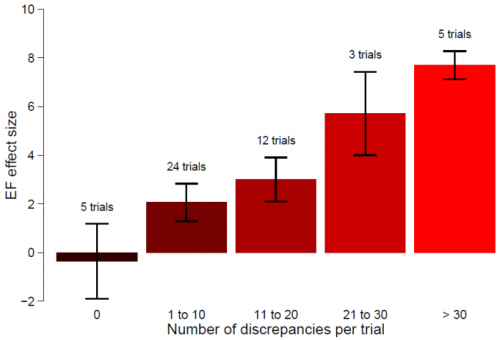Study of stem cell trials links discrepancies in data with reported success of treatment

New research looking at the success of clinical trials of stem cell therapy shows that trials appear to be more successful in studies where there are more discrepancies in the trial data.
Researchers from Imperial College London conducted a meta-analysis of 49 randomised controlled trials of bone marrow stem cell therapy for heart disease. The study, published today in the British Medical Journal, identified and listed over 600 discrepancies within the trial reports.
Discrepancies were defined as two (or more) reported facts that could not both be accurate because they were logically or mathematically incompatible. For example, one trial reported that it involved 70 patients, who were divided into two groups of 35 and 80.
The researchers found eight trials that each contained over 20 discrepancies.
The researchers found that the discrepancy count in a trial was the most important determinant of the improvement in cardiac function reported by that trial. Trials with fewer and fewer discrepancies showed progressively smaller improvements in cardiac function. The five trials with no discrepancies at all showed an effect size of zero (see bar chart).
Previous meta-analyses looking at the results of lots of clinical trials have suggested that on average, bone marrow stem cell therapy has a significant positive effect on improving heart function. However, some trials have shown that it successfully improves heart function whilst others have not. The reasons for this are unclear.
Professor Darrel Francis, one of the study authors from the National Heart and Lung Institute at Imperial College London, said: "Clinical trials involve a huge amount of data and so it is understandable that discrepancies sometimes arise when researchers are presenting their findings. However, our study suggests that these discrepancies can have a significant impact on the overall results. It is a powerful reminder to all of us conducting clinical trials to be careful and vigilant to avoid discrepancies appearing in the work.
"Furthermore, the scientific journals that publish the studies have a hugely important role and overall, there is much room for improvement in terms of how they deal with discrepancies when they come to light. Journals need to be transparent and publish discrepancies when they are identified. Our work suggests that this is not happening at the moment," he added.
Bone marrow stem cell therapy involves taking stem cells from the bone marrow in the hip and infusing these into the heart, with the aim that these cells will turn into new heart muscle cells and help the heart repair. It is currently at an experimental stage and is not in use as a standard treatment.
"Unfortunately, our research suggests that at present, it's not possible to give patients a clear picture of whether or not bone marrow stem cell therapy will be an effective treatment for heart disease. However, a large, carefully planned study of this kind of therapy is just starting, involving thousands of patients. This has rigorous protocols in place to ensure that the data are as reliable and useful as possible. I hope that this trial, which is known as BAMI, will provide us with some much-needed answers," concluded Professor Francis.
More information: "Discrepancies in autologous bone marrow stem cell trials and enhancement of ejection fraction (DAMASCENE): weighted regression and meta-analysis" British Medical Journal, Tuesday 29 April 2014.















